The Mosaics (previously at St. John)
The Great Catch
(Based on Luke 5:4-11)
Donated by Mr. and Mrs. Roy Schoen
The mural records the words of Jesus as he challenges Simon Peter and the rest of the fishermen to follow him. As you view the panel, note the black poles. They are the piers on which the nets were draped to dry. There are barnacles attached to the piers which represent the many imaginable excuses people use to justify their indifference to Jesus’ invitation. Even Simon’s excuse is written on the wood. He said, “We have toiled all night and took nothing.”
Jesus is depicted by the white figure in the mosaic, peering into the water. He knows that there are a lot of fish in the sea as illustrated by the fish in the blue waters at the bottom of the mosaic. Those fish represent all people who are swimming around aimlessly, trying to cope in a broken world. They have never heard about the impact a relationship with God can have on their lives.
The artist writes out in the white tiles Jesus’ challenge to Simon as he said, “Put out into the deep and let down your nets for a catch.” Notice that the nets are lined with small crosses which are the common symbols of Christ’s sacrifice that paid for the sins of all thus restoring our relationship with God. The “nets” or the Gospel is to be thrown into the sea to catch the fish. This message challenges us to communicate the gospel to the people in our own “ponds”.
As the story continues, you know the disciples threw their nets into the water and caught so many fish that they had to yell for another boat to come and help. Both boats were overloaded with fish to the point of sinking. You can bet that the disciples were more than just amazed. Then Jesus concluded with the phrase inscribed on the nets at the top of the mosaic. “Follow me, and I will make you fishers of men.” That same invitation is extended to all generations of people who have had the opportunity to come to know Christ as their personal Lord and Savior. So take the challenge, and go fish.


JOHN
(Based on John 3:16 & Revelation 22)
In memory of Emma Sieving
by Clara L. Sieving and Esther Gotsch
The focus of this mosaic is the beautiful “Tree of Life”. Inspiration is from the book of Revelation showing the vision of John.
The tree springs out of the river of the water of life (God’s Word). Alpha and omega symbols in the roots show that Christ is the root of life. In the branches are the twelve pieces of fruit seen by John in his vision.
Prominent is the message of John 3:16. “For God so loved the world that he gave his only begotten son. That whosoever believeth in him should not perish but have everlasting life.” The passage is followed by a representation of the heart of God. The red letters “LOVE” stand out centering our attention on the importance of God’s saving love; reminding us that this love is shown through Jesus’ blood.
John’s profession as a fisherman is indicated by the rocks and water. Ephesus and Asia Minor, where he ministered, are inscribed at the lower left. The eagle at the upper right is the symbol of John and indicates the “Soaring to Heaven” quality of his writings.
MATTHEW
(Based on Matthew 19:16-26)
Gift of Thanksgiving
by Prof. and Mrs. William H. Lehmann, Jr.
Matthew was a rich man, a publican, who collected taxes for the Roman government. This is depicted by the coins at the top. The coins at the bottom indicate Matthew became a soul collector under Jesus. Note the differences between the coins. The coins at the top of the mural are made of brass, lead, silver, and contain the image of Caesar. They are set in a field of red, to indicate both the bloodshed in the Roman conquests and nationalism.
The soul coins towards the bottom of the mural, in contrast, are made only of gold and imprinted with the cross of Christ and the places where Matthew preached about him. They are set in a field of blue to indicate Matthew’s loyalty to Christ. His name is in blue, again to stress his loyalty to his only master.
The main portion of the mosaic is the passage, “It is easier for a camel to go through the eye of a needle than for a rich man to enter into the kingdom of God.” Here two walls are pierced by a shaft of light. The coin at the top cannot fit into the opening. We are reminded of the small opening in the wall of Jerusalem, often called the “needle’s eye”, through which people could enter the city when the regular gates were closed. Its size was such that a camel could squeeze through only in a kneeling position and not with packs or baggage on him.
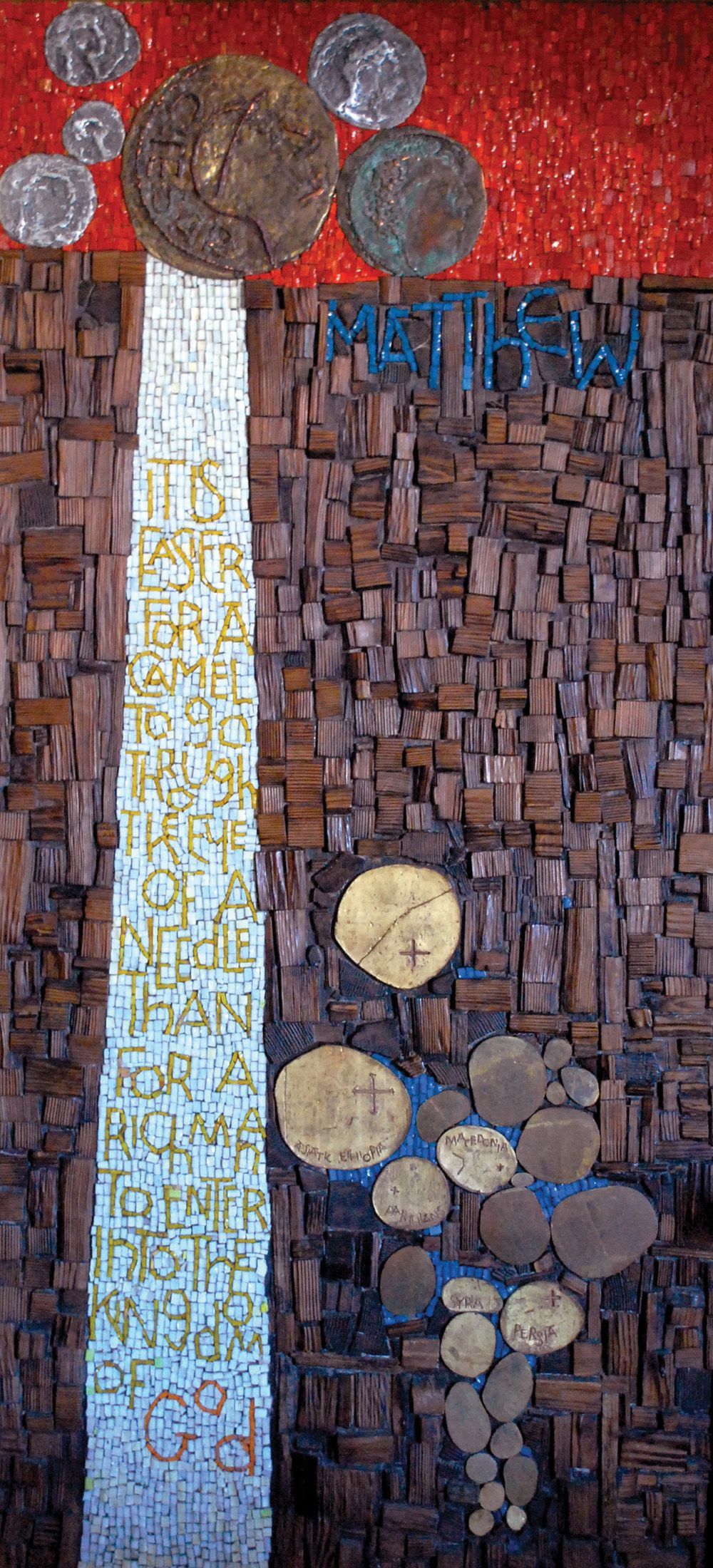
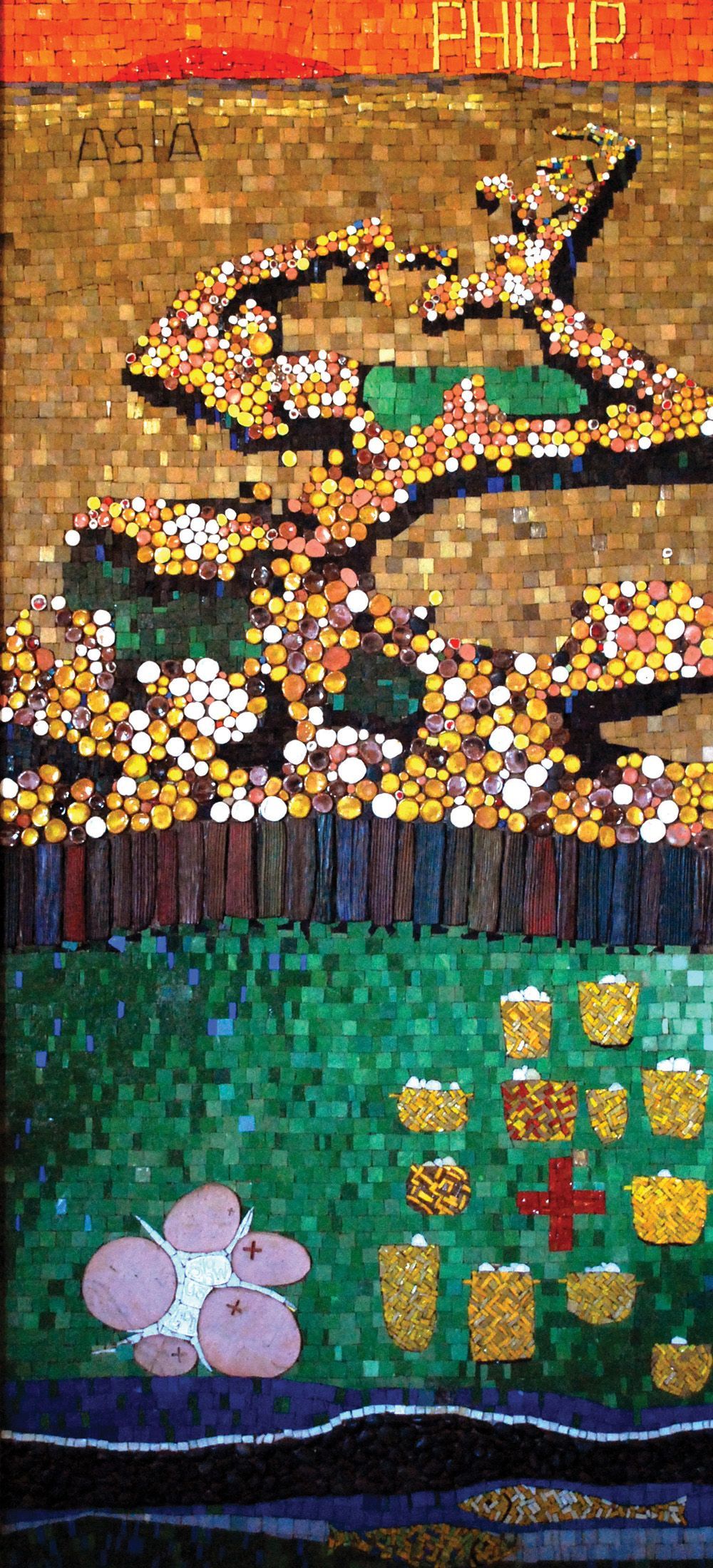
PHILIP
(Based on Matthew 14:13-21)
In memory of
Mr. and Mrs. Ernest Oeschlin, Sr.
This mosaic symbolically tells the story of the “Feeding of the Five Thousand”.
Philip is the disciple who wanted to see something physical to support his faith. Despite all his experience as a follower of Christ, he still asked Jesus, “Show us God.” These words are placed amid the five loaves. Also present in this area of the mosaic are the two fishes, and the twelve full baskets that remained after the feeding of the crowd.
In the middle of the mosaic the crowd is represented by a row of people. Notice their feet, rectangular bodies, and circular heads. Behind them are the heads and bodies of the other thousands of people also represented by similar shapes.
Jesus answered Philip by showing God through his miracles and through the actions of his followers.
SIMON
In memory of Mr. and Mrs. Emil Roehlke
by Family and Friends
Simon was called the “Zealot” because of his political feelings. He was a member of a strongly patriotic group who worked for the restoration of the theocracy of Israel. This is shown in the mosaic by the Star of David (symbol of theocracy). It is in white indicating the Messiah would come to rule with purity and justice.
Opposite the star is the Roman authority of coins, and a balance scale. Above the scale is an eagle on an archway with a gray scepter extending vertically. The weights hang below the scale and tip towards the red cross (theocracy) in the center. This red cross is the focal point of the mosaic and became the center of Simon’s life. Domination of this in the mosaic is by the cross and the net (white lines) filled with fish.
The nationalist theme fades and the vocation fisher of men fills Simon. The base and strength of the mosaic in the lower half, shows Simon’s work for Christ in the areas noted on the fish.
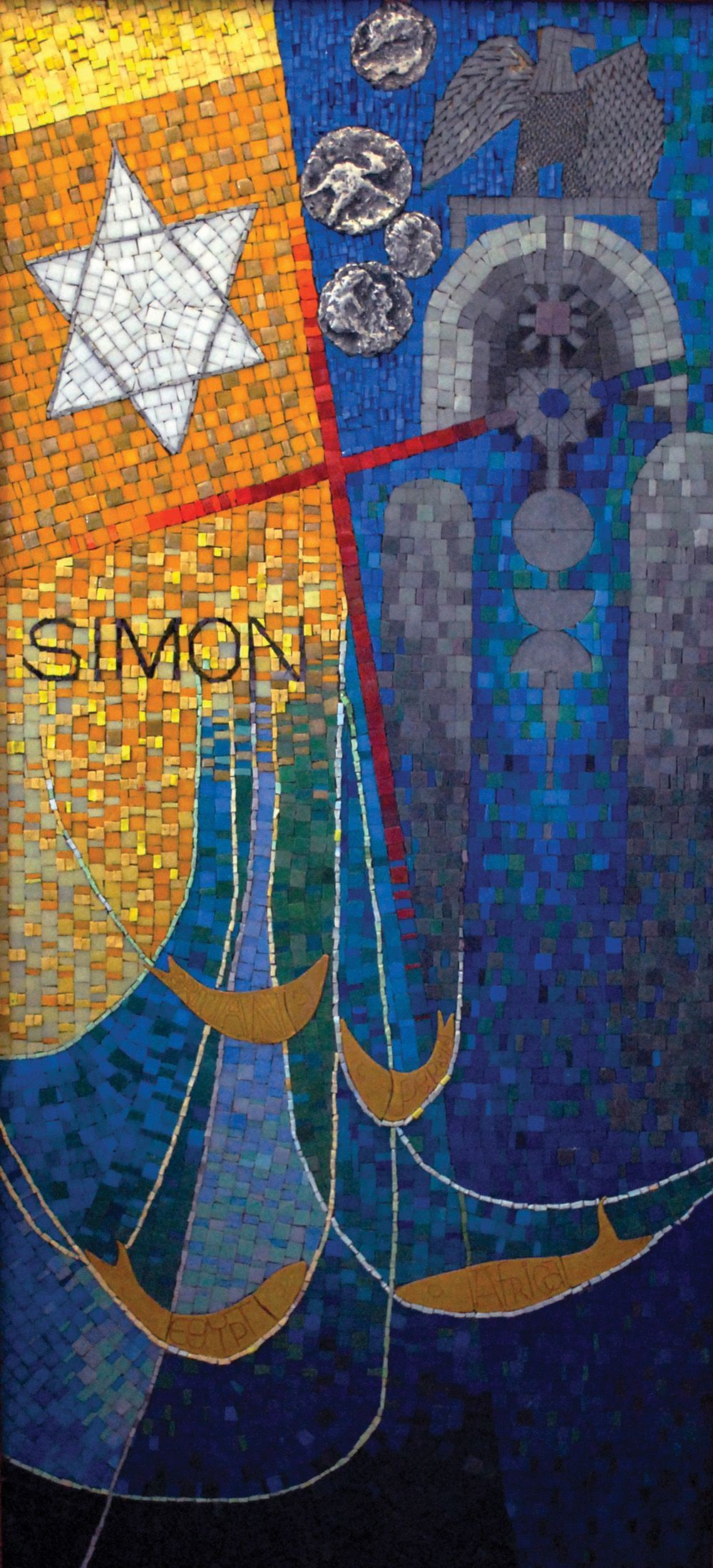
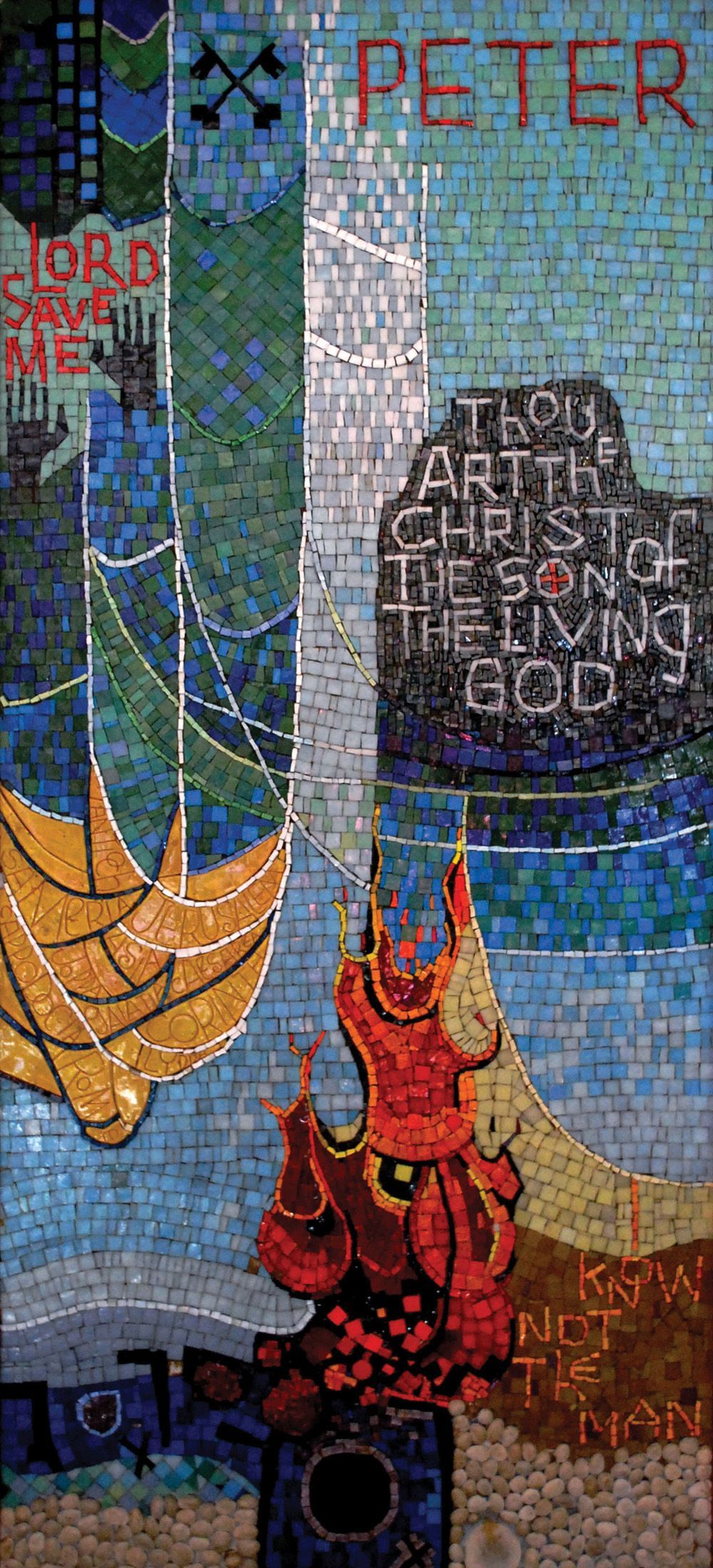
PETER
(Based on Matthew 16:13-19)
In memory of Mr. and Mrs. Gustav Petersohn
by Family
This mosaic directs us to the rock of our salvation. Peter’s affirmation, “Thou art the Christ, the Son of the living God” is the focus. The rock rises out of the denial near the fire. This indicates the growth of Peter’s faith from uncertainty and fear to certainty and confidence.
The yellow tones used in the denial, ”I know not the man”, suggests cowardice. At the base of the mosaic is the repeated 70 x 7. This reminds us that God’s forgiveness lies at the base of our faith.
The left side of the mosaic depicts Peter’s life. The bars at the upper left suggest his imprisonment; the net reminds us he was a fisherman; the names listed in it show his places of work as a fisher of men; and the sagging net shows the great success of his mission.
Most prominent are the hands reaching out of the water and the cry, “Lord, save me.” This is reference of Peter’s experience with Christ on the Sea of Galilee. The symbolism is much greater. The black hand depicts the sinner drowning in the world of sin and evil. His only help is the Lord, and he cries out to him. The red letters are the saving blood of Christ. This was Peter’s cry not only on the Sea of Galilee, but throughout his life.
Near the top, the “Keys of the Kingdom” remind us of the power given to the church on earth to forgive sins.
ANDREW
(Based on John 1:35-42)
In memory of Mr. A. G. Guemmer
by Mr. and Mrs. A. B. Guemmer,
Mrs. Louise Guemmer, Mr. and Mrs. H. Mathews
Andrew, known as the friendly disciple, shakes hands with a stranger. As the day went on, he realized this was Jesus. He points him to the wounded hand of Jesus. He tells his brother, “We have found the Messiah!”
This mosaic represents Andrew’s missionary work. Green, represents the water over which Andrew traveled to various islands.
The four heads at the bottom, suggest that Andrew brought the message that he found the Messiah to the four races of nations at that time.
It is believed that Andrew was crucified on a cross shaped as an “X”. This is depicted in the upper left corner by his name.

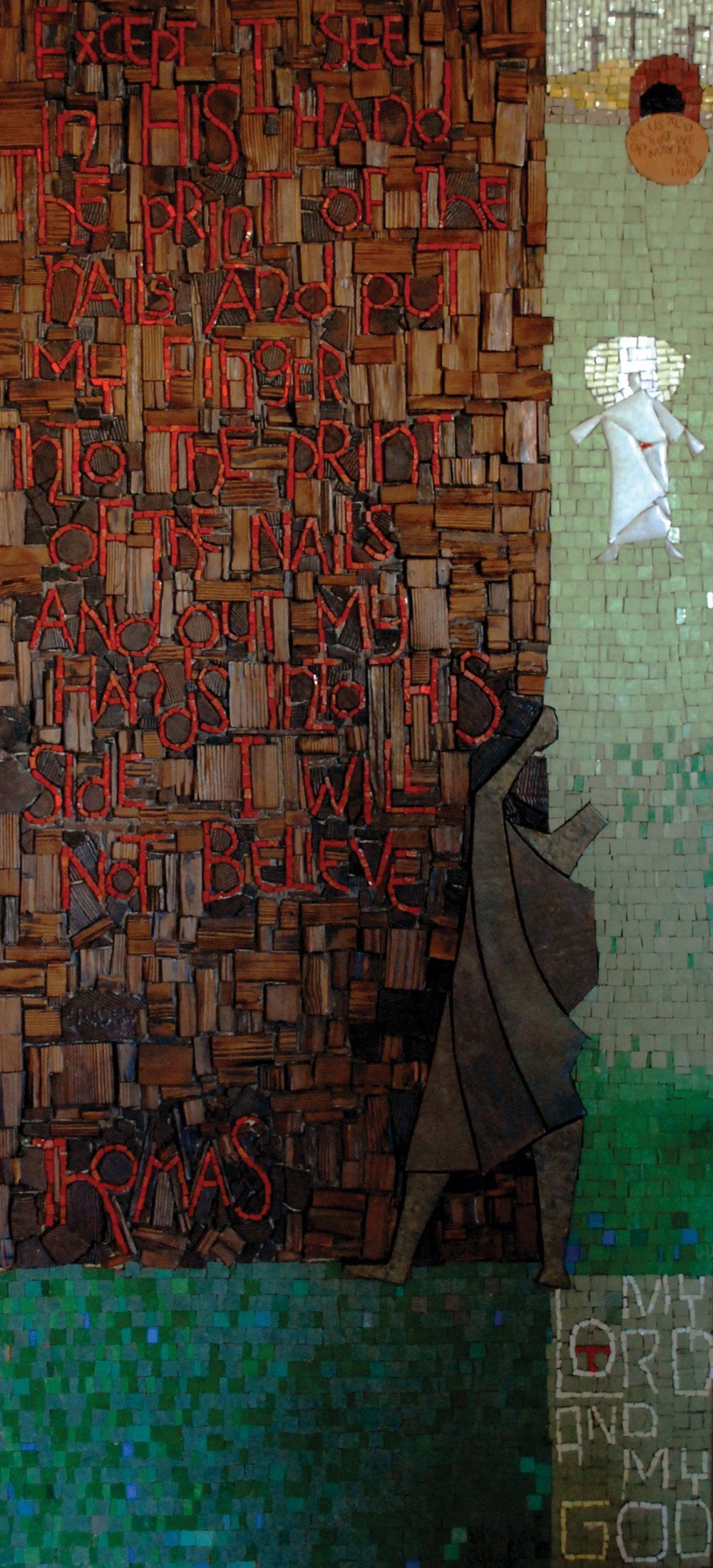
Thomas
(Based on John 20:24-28)
In memory of Mr. Herbert Schanoske
by Mr. and Mrs. E. C. Marquardt
This mosaic depicts the time in the life of Thomas when he doubted the resurrection of Christ. He is often given the nickname of, “Doubting Thomas”.
The tall brown wall is a “wall of unbelief and doubt” which was found in the mind of Thomas. On it we find his famous statement in bold red words, “Except I shall see in his hands the print of the nails and put my finger into the print of the nails, and put my hand into his side, I will not believe.”
Note that Thomas, the skeptic, is peering around the wall, seeing the white figure of the risen Christ approaching him with outstretched hands.
At the top are the three crosses, a grave and an opened tomb verifying that Jesus was alive. In the lower right corner, is the great confession of faith by Thomas upon seeing Jesus, “My Lord and my God.”
Thomas is believed to have preached in Parthia, Persia and India. The word India is written in nails to represent his mission work there.
JAMES
(Based on Luke 9:51-56 and Mark 10:35-45)
Gift of Thanksgiving
by Concordia Cemetery
This mosaic is one of contrast. Next to the peaceful scene at the bottom is juxtaposed by the fiery turbulence at the top. This juxtaposition is a representation of James’ life. To follow Jesus, he left a peaceful fisherman’s life and found instead a life of energy and zeal that ended in a martyr’s death.
The bottom of the mosaic depicts the forsaken life. The nets and the boat are tied up, the sails are furled. All is quiet. Just above this is a peaceful garden, the garden of Gethsemane, where James and the other disciples slept during Christ’s agony and prayer.
Next, is the fire that consumed the heart of James in his Lord’s service. This flame also reminds us of his zeal in defending the Lord’s honor. When a Samaritan village would not receive Christ, he and John asked, “Lord, do you want us to bid fire come down from heaven and consume them?”
Surrounding the flame are many curved lines. These lines and the yellow and orange colors create a feeling of turbulence. They suggest Christ’s name for James and John, “Sons of Thunder.”
At the top, the throne of Christ (with crown) is flanked by two smaller thrones imprinted with the request of James and John for personal glory. These remind us of the glorification of all Christians, not through personal merit, but because of the merit of Jesus’ blood.
The entire mosaic has a spirited look; even to the flamboyant lettering used for the name

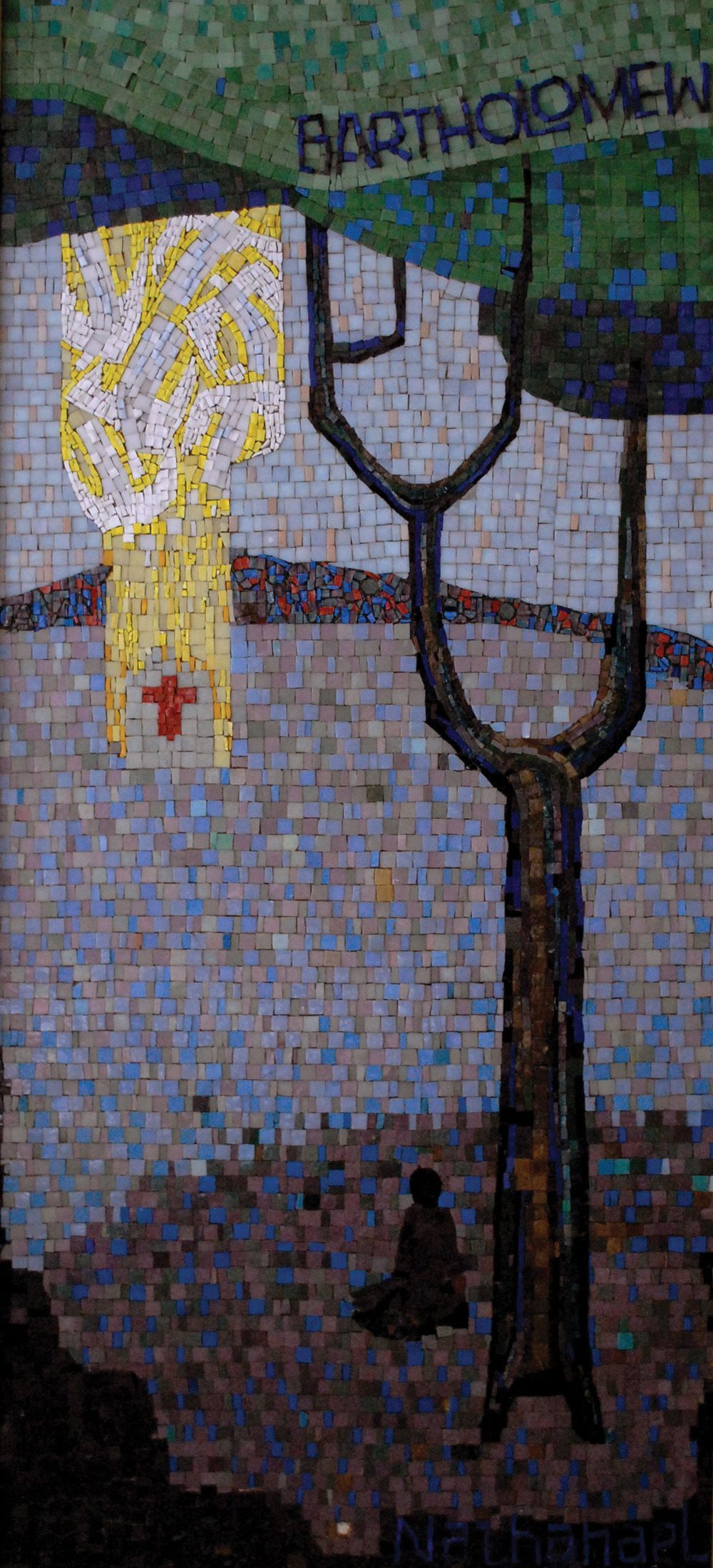
BARTHOLOMEW
(Based on John 1:43-51)
Gift of Thanksgiving
by Mr. and Mrs. Charles A. Heidelbach
When Philip brought the news of the Messiah to Bartholomew he said, “Can any good thing come out of Nazareth?” This question is found in the hills in the center of this panel.
Bartholomew found his answer when Christ said he saw him under the fig tree. This super-human knowledge convinced Bartholomew that Christ was the Messiah. The tree and the figure beneath it depict this episode.
Christ followed his greeting of Bartholomew with the statement that he would see visions of angels ascending and descending on the Son of God. This is indicated by the yellow and white angels over the red cross (Christ) in the left center of the panel. Christ also noted this was a man in whom there was no guile. The subdued colors reflect his quiet, meditative personality. His areas of preaching activity are noted at the lower left.
JAMES THE LESS
(Based on James 5:10-18)
Gift of Thanksgiving
by Mr. and Mrs. G. Lehmann
This mosaic depicts the power of prayer. It symbolically shows the story of Elijah which James repeats in his Epistle.
The orange sun beats down on the withering plant. Elijah prayed that God would withhold the rain. Then, in answer to his later prayer, the rain (blue lines at right) brings forth the “fruit of the earth” shown by the green plants.
The ceramic sections above the sun contain the words of James as he describes the story of Elijah’s faith in the power of prayer.
The curves at the bottom suggest the position of the kneeling supplicant. The figure of a camel’s foot at the bottom depicts James’ persistence in prayer. His knees were so often bent in supplication that they resembled the feet of a camel.

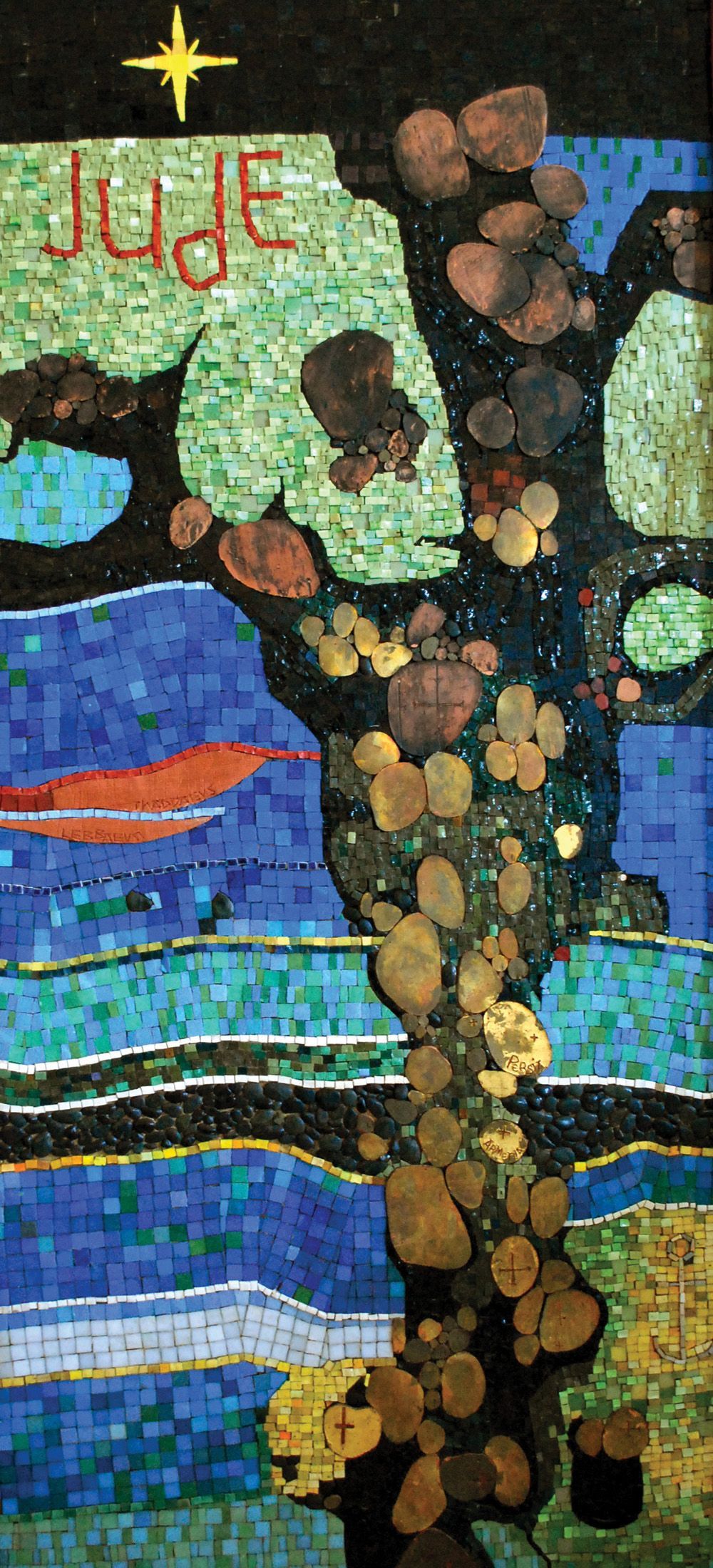
JUDE
Gift of Thanksgiving
by Dr. and Mrs. Wangerin
“Missionary Outreach” is another name for this mosaic. It symbolizes the spread of the message of Jesus through the Apostles.
The dark areas denote various continents surrounded by water. The blue is the water, and the green tiles are the land.
The anchor (lower right) represents the word brought by ship to far-off lands. The beige colored shapes, some with crosses, suggest the Word of God turns souls into “gold.” Green areas near gold are new life. The darker areas are those which have not yet received the Gospel.
On the left are two ship-like forms imprinted with the names Lebbaeus and Thaddaeus. These were other names for Jude.
The star at the upper left recalls the legend that Jude was one of the shepherds of Bethlehem. He supposedly stayed at the manger, and Mary put Jesus into his arms. When he grew up, he became a disciple of Jesus.
JUDAS
(Based on Matthew 27:3-10)
In memory of Mr. John Benedeck
by Mrs. John Benedeck
A dead tree is the central figure of the mosaic. The symbol of “the betrayer”, Judas is pictured this way because there was no life in him.
On the tree are the quotations of Judas: “Why was this ointment not sold for 300 denarii and given to the poor?”; “Is it I master?”; “The one I kiss is the man, seize him”; “What will you give me if I deliver him to you?”
The tree is executed in tones of brown, gray, and black to show the sin and death that filled Judas.
Coin shapes at the roots suggest his thievery and greed. These coins of greed or blackness of sin also block the blue water of life from feeding the tree.
At the center left is the skull of death. This also resembles a Roman coin-the symbol of Judas’ betrayal of Christ.
The background of yellow stones in various angles shows agony, turbulence, and cowardice.


